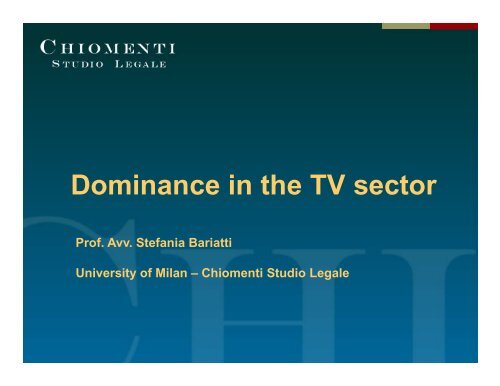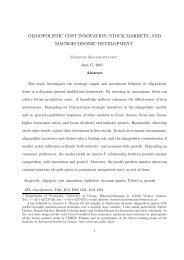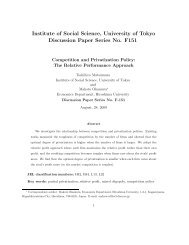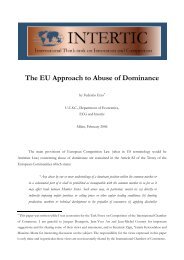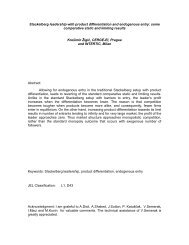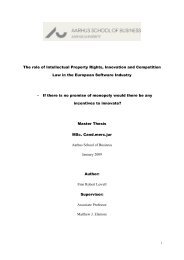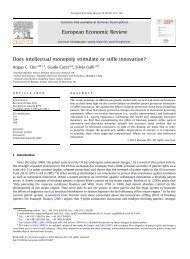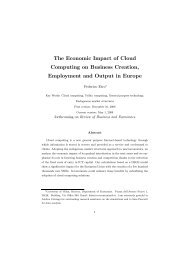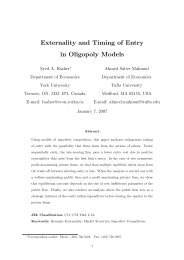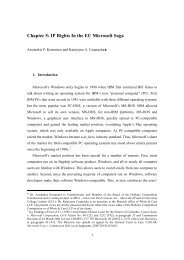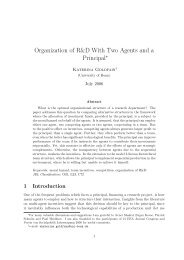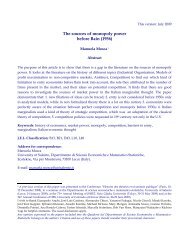Stefania Bariatti (Studio Legale Chiomenti, Milan) - Intertic
Stefania Bariatti (Studio Legale Chiomenti, Milan) - Intertic
Stefania Bariatti (Studio Legale Chiomenti, Milan) - Intertic
Create successful ePaper yourself
Turn your PDF publications into a flip-book with our unique Google optimized e-Paper software.
Dominance in the TV sector<br />
Prof. Avv. <strong>Stefania</strong> <strong>Bariatti</strong><br />
University of <strong>Milan</strong> – <strong>Chiomenti</strong> <strong>Studio</strong> <strong>Legale</strong>
Prliminary remarks: the relationship between pluralism,<br />
regulatory competition and competition law<br />
The Guidelines on Article 82: refusal to supply in the TV<br />
sector<br />
Final remarks
The relationship between competition law and the<br />
protection of pluralism in general [1]<br />
• Competition law should aim at “protecting an effective<br />
competitive process and not simply competitors” (Commission<br />
Guidelines, § 6).<br />
• On the contrary, protection of external pluralism aims at<br />
assuring the presence of a certain number of sources of<br />
information in the markets so that internal pluralism can be<br />
potentially assured as well.<br />
• NCA protects competition law and NRA protects pluralism<br />
(external and internal component).
The relationship between competition law and the protection<br />
of pluralism (external component): the Italian framework [2]<br />
• AGCom (NRA)and external pluralism.<br />
• Each Country can fix ex ante limits;<br />
• < 20% channels;<br />
• < 20% revenues on “SIC” or single market composing it;<br />
• Must-carry obligation (40% of MUX capacity).<br />
• AGCM (NCA) and competition law. No fixed limits:<br />
• Decreasing role of “per se rule” and increasing role of<br />
the “rule of reason” (GlaxoSmithKline, T-168/01).
The relationship between regulatory competition and<br />
competition law [1]<br />
• The goal of the New Regulatory Famework 2002 on<br />
electronic communication networks and services<br />
(“NRF”) was to foster competitiveness (competitive<br />
injection in the value chain) within regulated industries<br />
in a critical lapse of time (the IP converged Era) so<br />
that the latter could be progressively subjected to<br />
competition law only.<br />
•Furthermore the NRF pursues public interest<br />
objectives which h cannot be delivered d through h<br />
competition law, such as cultural diversity and media<br />
pluralism (i.e. external pluralism)
The relationship between regulatory competition and<br />
competition law [2]<br />
• NRF builds on key features of competition law (market<br />
definition iti and concept of dominance, see Significant ifi Market<br />
Power or SMP Guidelines)<br />
• It does not mean that analysis carried out pursuant to NRF<br />
will always lead to the same result of competition law<br />
enforcement (e.g. definition of markets and of dominant firm<br />
may differ)<br />
• First Recommendation on relevant market (2003) contained<br />
• First Recommendation on relevant market (2003), contained<br />
a list of markets that should be anlysed by NRA for imposing<br />
ex-ante remedies upon SMP operators.
The relationship between regulatory competition and<br />
competition law [3]<br />
• Procedure<br />
Market identification: (i) high and non transitory entry barriers, (ii)<br />
structure that does not tend towards effective competition within the<br />
relevant time horizon and (iii) competition law remedies not sufficient<br />
(i.e. principle of subsidiarity) (“Three Criteria Test”).<br />
• SMP firm: m.s. > 40%<br />
• Notwithstanding point (iii) above, the Commission has<br />
acknowledged the possibility of parallel procedures res under<br />
regulatory competition and competition law (SMP<br />
Guidelines, § 31 and note 15).
The relationship between regulatory competition and<br />
competition law: the Italian framework [4]<br />
• With respect to TV sector, the list annexed to the 2003<br />
Recommendation identified the “Broadcasting transmission<br />
services, to deliver broadcast content to end users” (market n.<br />
18).<br />
• Yet, AGCom (NRA) so far addressed the “wholesale market<br />
for analog transmission services…” (136/05/CONS,<br />
544/07/CONS, 159/08/CONS).<br />
• AGCM experience in so far (since 2003): upstream market of<br />
content acquisition (A362), upstream market of access to<br />
broadcasting infrastructure (C6161), downstream markets and<br />
all the so-called “emerging markets” (C7493). New alleged DP<br />
case (Conto TV)
Prliminary remarks: the relationship between pluralism,<br />
regulatory competition and competition law<br />
The Guidance Paper on Article 82: refusal to supply<br />
in the TV sector<br />
Final remarks
Refusal to supply: the concept [1]<br />
The “center of gravity” test<br />
• The refusal should be opposed by a vertically<br />
integrated dominant undertaking to buyer which<br />
competes on its “downstream” market.
Final remarks: actual v. constructive refusal to supply<br />
• Notwithstanding Chapter IV.D of the Guidelines is titled “Refusal to<br />
deal and margin squeeze” very little attention has been given to the<br />
latter (§ 80).<br />
• However, it is recognized that this practice could be one of the most<br />
pervicacious in the TV sector since normally the dominant undertaking<br />
might decide to put in place a constructive refusal, especially ex-post<br />
margin squeeze (“margin squeeze”).<br />
• Furthermore, § 80 deals only with discriminatory margin squeeze,<br />
while it is recognized that dominant firms face higher incentive to put<br />
in place non-discriminatory margin squeeze especially where firms<br />
are vertically integrated and upstream market is regulated.<br />
• Finally, the Guidelines appear somewhat incomplete since a clear<br />
distinction between exclusionary and exploitative practices cannot<br />
always be drawn up in practice.


